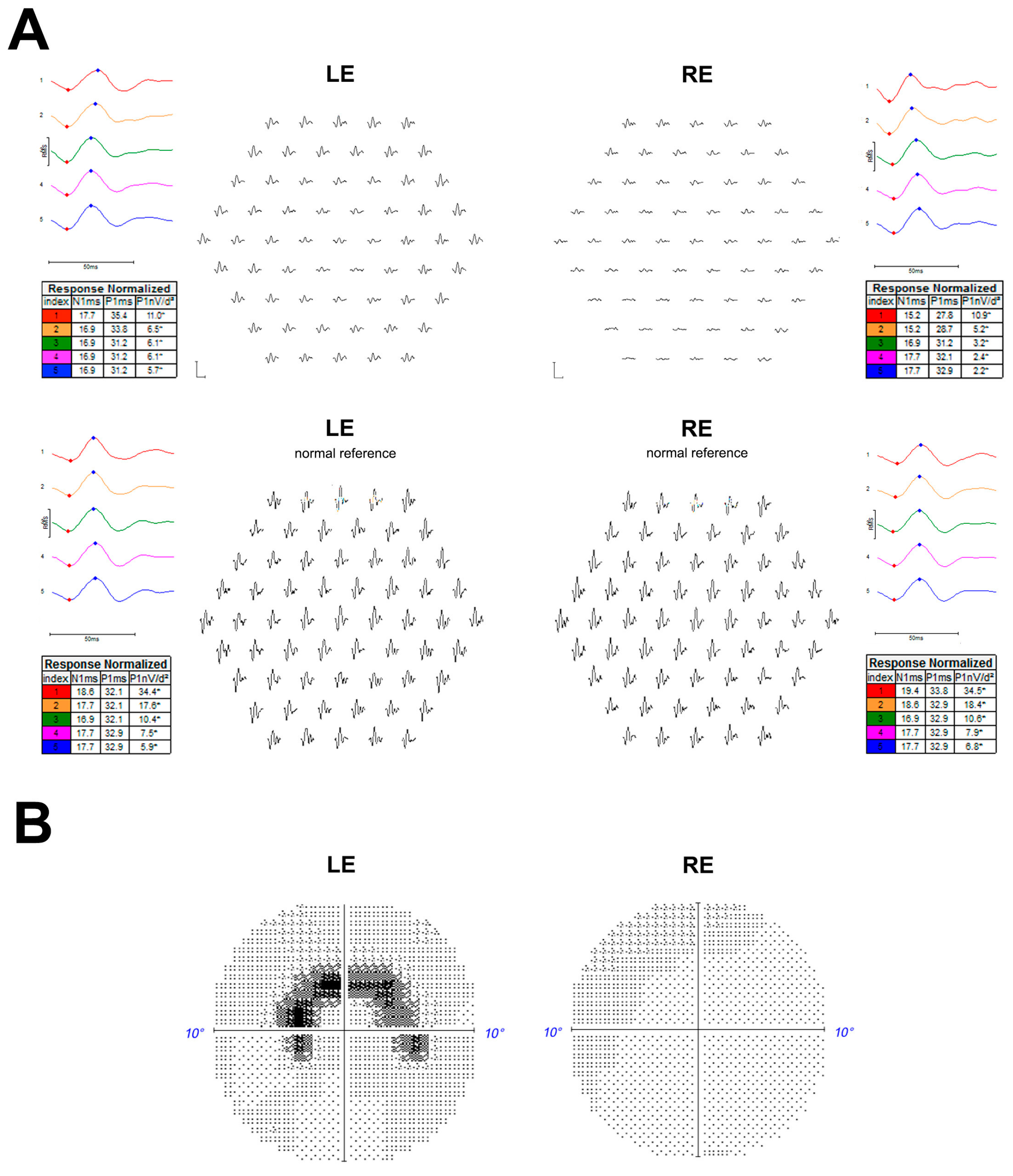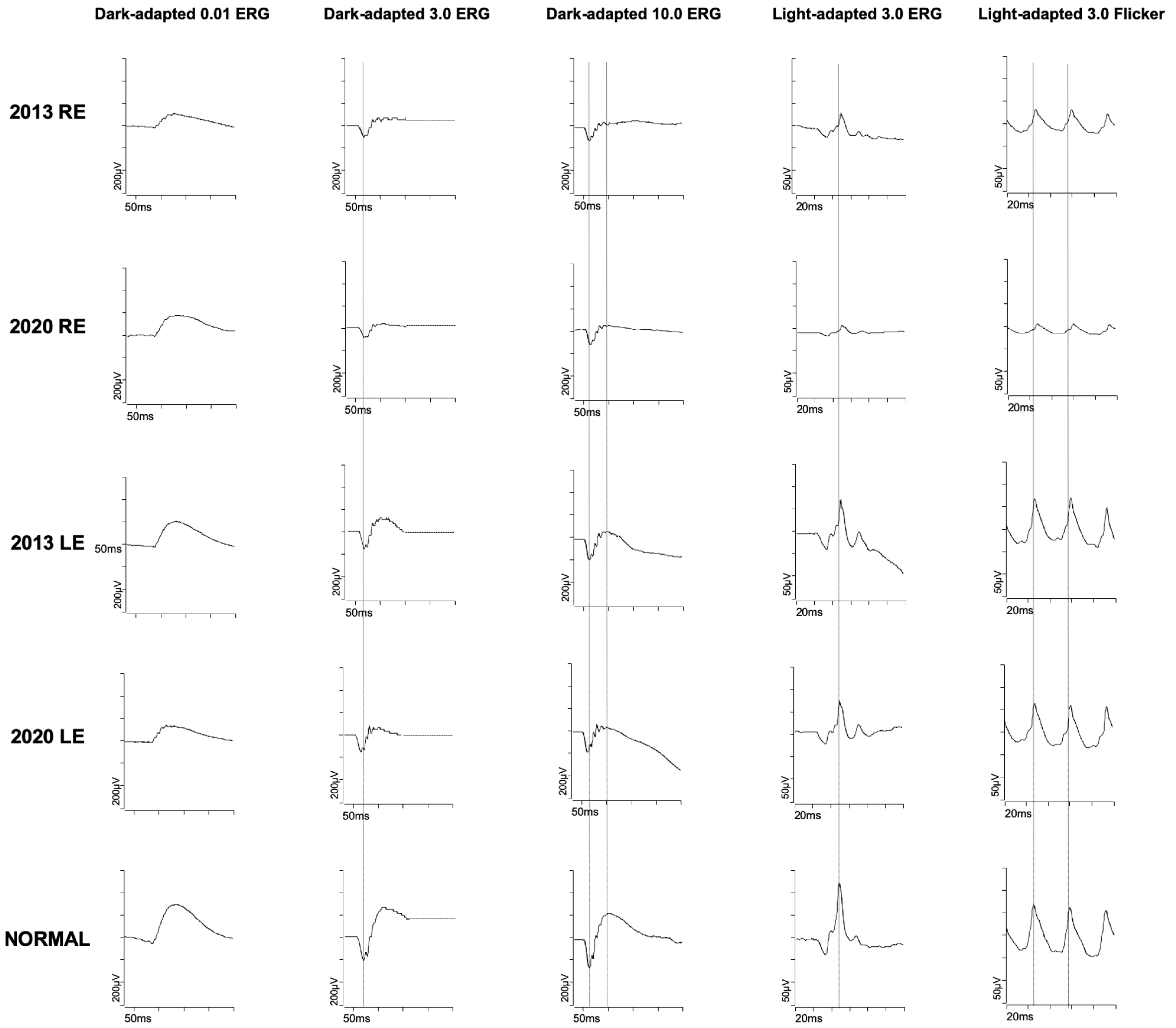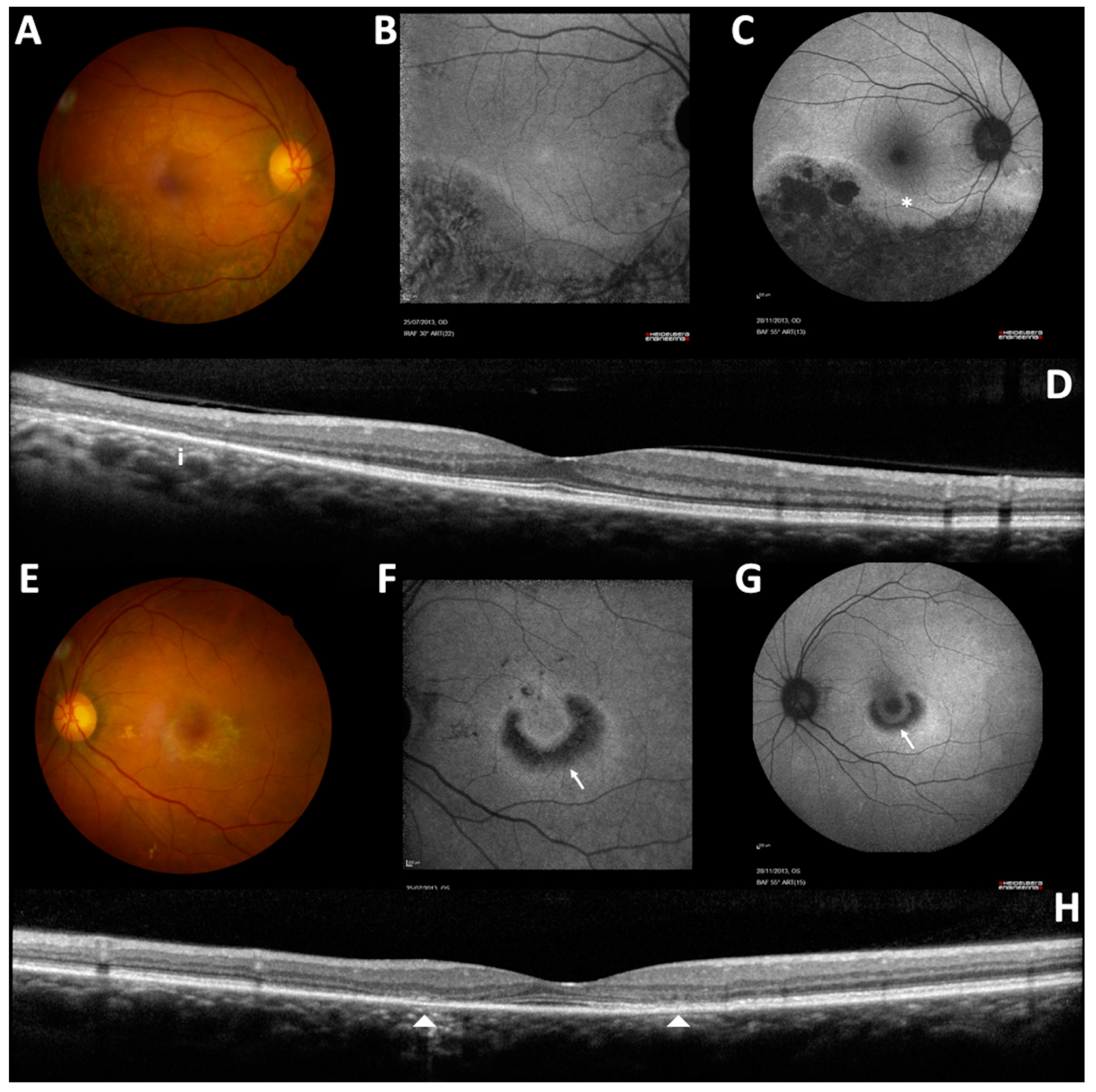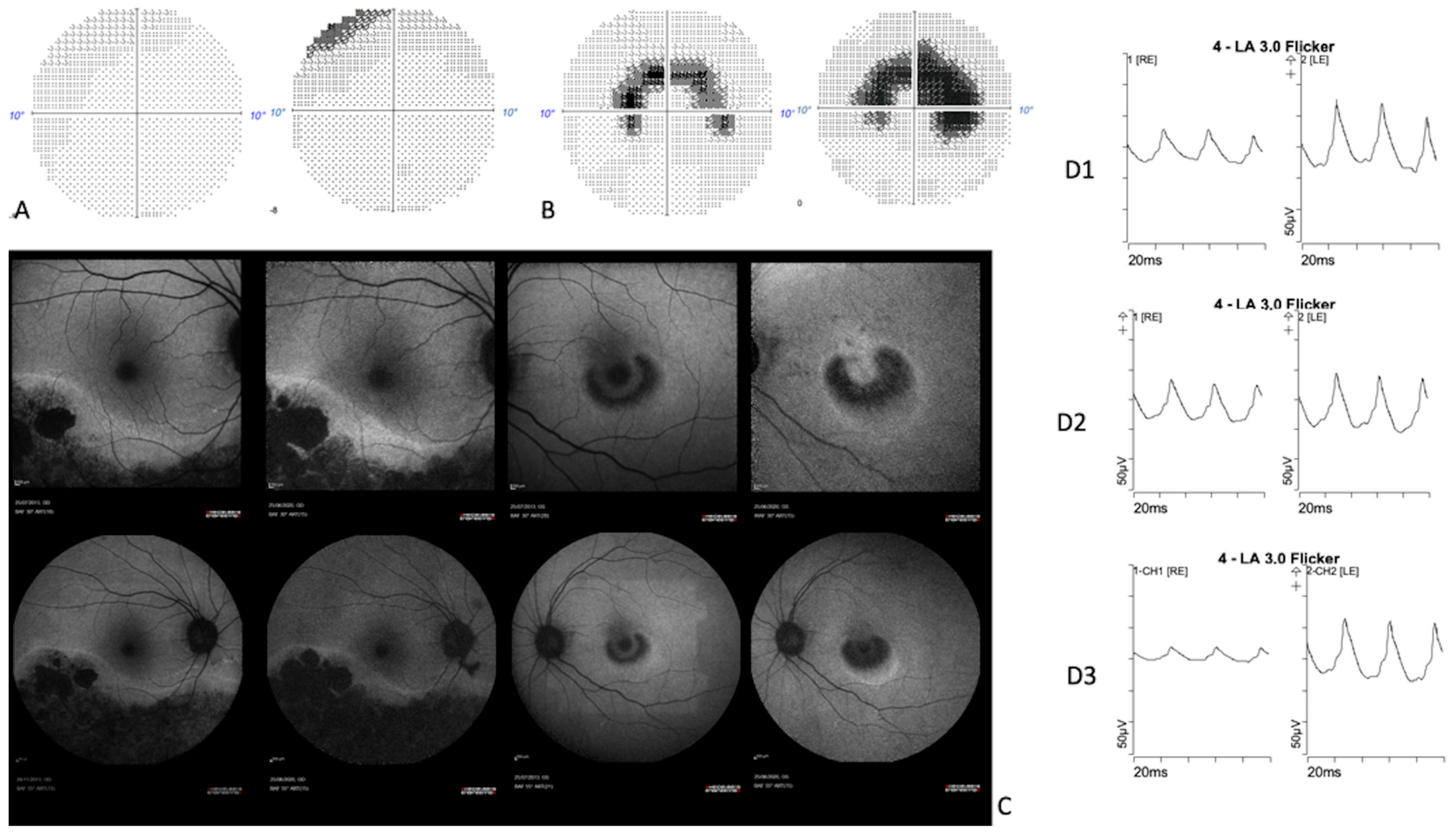Extreme Interocular Asymmetry in an Atypical Case of a Hydroxychloroquine-Related Retinopathy
Abstract
:1. Introduction
2. Case Presentation
3. Discussion
4. Conclusions
Author Contributions
Funding
Institutional Review Board Statement
Informed Consent Statement
Data Availability Statement
Conflicts of Interest
References
- Melles, R.B.; Marmor, M.F. The risk of toxic retinopathy in patients on long-term hydroxychloroquine therapy. JAMA Ophthalmol. 2014, 132, 1453–1460. [Google Scholar] [CrossRef] [PubMed] [Green Version]
- Melles, R.B.; Marmor, M.F. Pericentral retinopathy and racial differences in hydroxychloroquine toxicity. Ophthalmology 2015, 122, 110–116. [Google Scholar] [CrossRef] [PubMed]
- Anand, N.; Prinzi, R.A.; Hoeferlin, C.; Yan, J.; Jain, N. Pericentral hydroxychloroquine retinopathy in a Caucasian female. Am. J. Ophthalmol. Case Rep. 2018, 9, 93–95. [Google Scholar] [CrossRef]
- Lee, D.H.; Melles, R.B.; Joe, S.G.; Lee, J.Y.; Kim, J.-G.; Lee, C.-K.; Yoo, B.; Koo, B.S.; Kim, J.T.; Marmor, M.F.; et al. Pericentral Hydroxychloroquine Retinopathy in Korean Patients. Ophthalmology 2015, 122, 1252–1256. [Google Scholar] [CrossRef] [PubMed] [Green Version]
- Hood, D.C.; Bach, M.; Brigell, M.; Keating, D.; Kondo, M.; Lyons, J.S.; Marmor, M.F.; McCulloch, D.L.; Palmowski-Wolfe, A.M.; International Society for Clinical Electrophysiology of Vision. ISCEV standard for clinical multifocal electroretinography (mfERG) (2011 edition). Doc. Ophthalmol. 2012, 124, 1–13. [Google Scholar] [CrossRef]
- McCulloch, D.L.; Marmor, M.F.; Brigell, M.G.; Hamilton, R.; Holder, G.E.; Tzekov, R.; Bach, M. ISCEV Standard for full-field clinical electroretinography (2015 update). Doc. Ophthalmol. 2015, 130, 1–12. [Google Scholar] [CrossRef]
- Marmor, M.F.; Kellner, U.; Lai, T.Y.Y.; Melles, R.B.; Mieler, W.F.; American Academy of Ophthalmology. Recommendations on Screening for Chloroquine and Hydroxychloroquine Retinopathy (2016 Revision). Ophthalmology 2016, 123, 1386–1394. [Google Scholar] [CrossRef] [Green Version]
- Eo, D.; Lee, M.G.; Ham, D.-I.; Kang, S.W.; Lee, J.; Cha, H.S.; Koh, E.; Kim, S.J. Frequency and Clinical Characteristics of Hydroxychloroquine Retinopathy in Korean Patients with Rheumatologic Diseases. J. Korean Med. Sci. 2017, 32, 522–527. [Google Scholar] [CrossRef]
- Dammacco, R. Systemic lupus erythematosus and ocular involvement: An overview. Clin. Exp. Med. 2018, 18, 135–149. [Google Scholar] [CrossRef]
- Furukawa, Y.; Yokoyama, S.; Tanaka, Y.; Kodera, M.; Kaga, T. A case of severe choroidal detachment in both eyes due to systemic lupus erythematosus. Am. J. Ophthalmol. Case Rep. 2020, 19, 100829. [Google Scholar] [CrossRef]
- Hayreh, S.S. Posterior ciliary artery circulation in health and disease: The Weisenfeld lecture. Invest. Ophthalmol. Vis. Sci. 2004, 45, 749–757. [Google Scholar] [CrossRef] [PubMed]
- Shah, D.N.; Al-Moujahed, A.; Newcomb, C.W.; Kaçmaz, R.O.; Daniel, E.; Thorne, J.E.; Foster, C.S.; Jabs, D.A.; Levy-Clarke, G.A.; Nussenblatt, R.B.; et al. Exudative Retinal Detachment in Ocular Inflammatory Diseases: Risk and Predictive Factors. Am. J. Ophthalmol. 2020, 218, 279–287. [Google Scholar] [CrossRef] [PubMed]
- Sartini, F.; Menchini, M.; Posarelli, C.; Casini, G.; Figus, M. Bullous Central Serous Chorioretinopathy: A Rare and Atypical Form of Central Serous Chorioretinopathy. A Systematic Review. Pharmaceuticals 2020, 13, E221. [Google Scholar] [CrossRef] [PubMed]
- Kaewsangthong, K.; Thoongsuwan, S.; Uiprasertkul, M.; Phasukkijwatana, N. Unusual non-nanophthalmic uveal effusion syndrome with histologically normal scleral architecture: A case report. BMC Ophthalmol. 2020, 20, 311. [Google Scholar] [CrossRef] [PubMed]
- Terubayashi, Y.; Morishita, S.; Kohmoto, R.; Mimura, M.; Fukumoto, M.; Sato, T.; Kobayashi, T.; Kida, T.; Ikeda, T. Type III uveal effusion syndrome suspected to be related to pachychoroid spectrum disease. Medicine 2020, 99, e21441. [Google Scholar] [CrossRef] [PubMed]
- Tzekov, R.T.; Serrato, A.; Marmor, M.F. ERG findings in patients using hydroxychloroquine. Doc. Ophthalmol. 2004, 108, 87–97. [Google Scholar] [CrossRef]
- Shroyer, N.F.; Lewis, R.A.; Lupski, J.R. Analysis of the ABCR (ABCA4) gene in 4-aminoquinoline retinopathy: Is retinal toxicity by chloroquine and hydroxychloroquine related to Stargardt disease? Am. J. Ophthalmol. 2001, 131, 761–766. [Google Scholar] [CrossRef]
- Grassmann, F.; Bergholz, R.; Mändl, J.; Jägle, H.; Ruether, K.; Weber, B.H.F. Common synonymous variants in ABCA4 are protective for chloroquine induced maculopathy (toxic maculopathy). BMC Ophthalmol. 2015, 15, 18. [Google Scholar] [CrossRef] [Green Version]
- Korthagen, N.M.; Bastiaans, J.; van Meurs, J.C.; van Bilsen, K.; van Hagen, P.M.; Dik, W.A. Chloroquine and Hydroxychloroquine Increase Retinal Pigment Epithelial Layer Permeability. J. Biochem. Mol. Toxicol. 2015, 29, 299–304. [Google Scholar] [CrossRef]
- Chen, S.J.; Cheng, C.Y.; Lee, A.F.; Lee, F.L.; Chou, J.C.; Hsu, W.M.; Liu, J.H. Pulsatile ocular blood flow in asymmetric exudative age related macular degeneration. Br. J. Ophthalmol. 2001, 85, 1411–1415. [Google Scholar] [CrossRef] [Green Version]
- Mack, H.G.; Fuzzard, D.R.W.; Symons, R.C.A.; Heriot, W.J. Asymmetric hydroxychloroquine macular toxicity with aphakic fellow eye. Retin. Cases Brief Rep. 2021, 15, 176–178. [Google Scholar] [CrossRef] [PubMed]




Publisher’s Note: MDPI stays neutral with regard to jurisdictional claims in published maps and institutional affiliations. |
© 2022 by the authors. Licensee MDPI, Basel, Switzerland. This article is an open access article distributed under the terms and conditions of the Creative Commons Attribution (CC BY) license (https://creativecommons.org/licenses/by/4.0/).
Share and Cite
Hallali, G.; Seyed, Z.; Maillard, A.-V.; Drine, K.; Lamour, L.; Faure, C.; Audo, I. Extreme Interocular Asymmetry in an Atypical Case of a Hydroxychloroquine-Related Retinopathy. Medicina 2022, 58, 967. https://doi.org/10.3390/medicina58070967
Hallali G, Seyed Z, Maillard A-V, Drine K, Lamour L, Faure C, Audo I. Extreme Interocular Asymmetry in an Atypical Case of a Hydroxychloroquine-Related Retinopathy. Medicina. 2022; 58(7):967. https://doi.org/10.3390/medicina58070967
Chicago/Turabian StyleHallali, Gabriel, Zari Seyed, Anne-Véronique Maillard, Karima Drine, Laurence Lamour, Céline Faure, and Isabelle Audo. 2022. "Extreme Interocular Asymmetry in an Atypical Case of a Hydroxychloroquine-Related Retinopathy" Medicina 58, no. 7: 967. https://doi.org/10.3390/medicina58070967
APA StyleHallali, G., Seyed, Z., Maillard, A.-V., Drine, K., Lamour, L., Faure, C., & Audo, I. (2022). Extreme Interocular Asymmetry in an Atypical Case of a Hydroxychloroquine-Related Retinopathy. Medicina, 58(7), 967. https://doi.org/10.3390/medicina58070967





